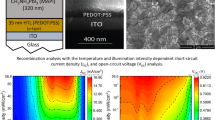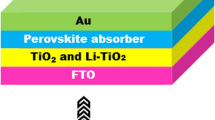Abstract
This decade witnessed rapid progress in the development of organic–inorganic hybrid lead-halide perovskite-based solar cells. In particular, this class of solar cells showed high-power conversion efficiency and significant potentiality to realize a low-cost terawatt-scale power generation. This is mainly due to its high optical absorption coefficient with sharp absorption onset, long charge-carrier lifetime, tunable bandgap, and low-cost fabrication. However, despite advancement in the device performance, the underlying physics of charge-carrier dynamics needs important attention to develop insight into the performance bottlenecks and thereby better control and optimization over the device performances. Among the performance bottlenecks, the charge-carrier recombination is considered to be one of the dominant mechanisms that limit solar cell behavior. Therefore, in this work, the underlying interest is to identify recombination mechanisms by simulating the temperature-dependent light ideality factor. We consider a standard sandwich device structure with CH3NH3PbI3 as an active layer. The Spiro and TiO2 are taken as a hole- and electron-transporting layers, respectively. We utilized a one-dimensional drift–diffusion equation to simulate temporal open-circuit voltage VOC (t) with varying light intensity, Φ, between 0.2 and 2.0 Sun equivalent and device temperature, T between 100 and 300 K. The temporal light ideality factor, nid,l (t) is determined by evaluating the slope of the plots between VOC (t) vs ln(Φ). The plot of temperature-dependent light ideality factor shows a fast rise in its value between the temperatures 100 to 150 K and tends slowly toward 2.0 as temperature increases. The observations clearly indicate that the recombination of charge-carriers is predominantly due to trap states, interfacial, or bulk, activated at higher temperatures. Further, the activation energy EA ~ 1 eV is obtained from the VOC vs T plot by extrapolating to T = 0. The value of EA matches with the interfacial energy gap between the perovskite and the electron- and hole-transporting layers corroborating the dominance of interfacial recombination. Thus, the work carried out shed light on the recombination mechanisms in such a class of solar cells and their alternative variants.






Similar content being viewed by others
Data availability
All data generated or analyzed during this study are included in this published article (and in its appendix).
References
APS News, April 25, 1954: Bell Labs demonstrates the first practical silicon solar cell, American Physical Society, vol. 18, 2009
D.M. Chapin et al., A new silicon p-n junction photocell for converting solar radiation into electrical power. J. Appl. Phys. 25, 676–677 (1954)
T. Zhang et al., A review of the energy performance and life-cycle assessment of building-integrated photovoltaic (BIPV) systems. Energies 11, 3157 (2018)
W.A. Badawy, A review on solar cells from Si-single crystals to porous materials and quantum dots. J. Adv. Res. 6, 123 (2015)
S. Hasiah et al., Electrical conductivity of chlorophyll with polythiophene thin film on indium tin oxide as P-N heterojunction solar cell. J. Phys. Sci. 19, 77 (2008)
O. Vigil et al., Route towards low cost-high efficiency second generation solar cells: current status and perspectives. J. Mater. Sci. 26, 5562 (2015)
J. Yan, B. Saunders, Third-generation solar cells: a review and comparison of polymer: fullerene, hybrid polymer and perovskite solar cells. RSC Adv. 4, 43286 (2014)
A. Kojima et al., Organometal halide perovskites as visible-light sensitizers for photovoltaic cells. J. Am. Chem. Soc. 131, 6050 (2009)
S.N. Habisreutinger et al., Carbon nanotube/polymer composites as a highly stable hole collection layer in perovskite solar cells. Nano Lett. 14, 5561 (2014)
F. Matteocci et al., Encapsulation for long-term stability enhancement of perovskite solar cells. Nano Energy 30, 162 (2016)
T. Leijtens et al., Overcoming ultraviolet light instability of sensitized TiO2 with meso-superstructured organometal tri-halide perovskite solar cells. Nat. Commun. (2013). https://doi.org/10.1038/ncomms3885
A. Pisoni et al., Ultra-low thermal conductivity in organic-inorganic hybrid perovskite CH3NH3PbI3. J. Phys. Chem. Lett. 5, 2488 (2014)
S. Shao et al., Highly reproducible Sn-based hybrid perovskite solar cells with 9% efficiency. Adv. Energy Mater. 8, 1702019 (2017)
S.D. Stranks et al., Electron-hole diffusion lengths exceeding 1 micrometer in an organometal trihalide perovskite absorber. Science 342, 341–344 (2013)
C. Wehrenfennig et al., High charge carrier mobilities and lifetimes in organolead trihalide perovskites. Adv. Mater 26, 1584 (2014)
V.M. Bergmann et al., Real-space observation of unbalanced charge distribution inside a perovskite-sensitized solar cell. Nat. Commun. (2014). https://doi.org/10.1038/ncomms6001
E. Edri et al., Elucidating the charge carrier separation and working mechanism of CH3NH3PbI3-xClx perovskite solar cells. Nat. Commun. (2014). https://doi.org/10.1038/ncomms4461
A. Guerrero et al., Electrical field profile and doping in planar lead halide perovskite solar cells. Appl. Phys. Lett. 105, 133902 (2014)
S. M. Sze, Physics and properties of semiconductors - a resume, in Book: Physics of Semiconductor Devices, Wiley, New York, 1969.
W. Shockley, W. T. Read, Statistics of the recombinations of holes and electrons, Phys. Rev. 87, 835, 1952.
R.N. Hall, Germanium rectifier characteristics. Phys. Rev. 83, 228 (1951)
S. M. Sze, Carrier transport phenomena, in Book: Semiconductor Devices, Physics and Technology, 2nd edn, Wiley, New York, 2002.
P. Philip et al., Identifying dominant recombination mechanisms in perovskite solar cells by measuring the transient ideality factor. Phys. Rev. Appl., 2019. https://doi.org/10.1103/PhysRevApplied.11.044005
R. Scheer, Activation energy of heterojunction diode currents in the limit of interface recombination, J. Appl. Phys., 105, 104505, 2009.
T. Kirchartz et al., On the differences between dark and light ideality factor in polymer:fullerene solar cells, J. Phy. Chem. Lett., 4, 2371, 2013.
LJA Koester et al., Device model for the operation of polymer/fullerene bulk heterojunction solar cells, Phys. Rev. B, 2005. https://doi.org/10.1103/PhysRevB.72.085205
C. Philip et al., Evidence for ion migration in hybrid perovskite solar cells with minimal hysteresis, Nat. Commun., 2016. https://doi.org/10.1038/ncomms13831
Author information
Authors and Affiliations
Corresponding author
Ethics declarations
Conflict of interest
On behalf of all authors, the corresponding author states that there is no conflict of interest.
Appendix: Description of parameters utilized for simulation
Appendix: Description of parameters utilized for simulation
Description | Symbol | Value | Unit |
|---|---|---|---|
Boltzmann constant | k B | 8.62 × 10–5 | eV K−1 |
Permittivity of free space | ε0 | 552434 | e2 eV−1 cm−1 |
Charge of the species in units of e | q | 1 | |
Elementary charge | e | 1.62 × 10–19 | C |
Temperature | T | 100—300 | K |
Layer and subsection thickness array | d cell | {{200 × 10–7}; {2 × 10–7, 340 × 10–7, 2 × 10–7}; {100 × 10–7}} | cm |
Number of points in layers and subsections array | p cell | {{100}; {40, 200, 40}; {100}} | |
Interfacial region thickness | d int | 2 × 10–7 | cm |
Interfacial points | p int | 40 | |
Toggle Open Circuit | OC | Closed Circuit = 0, Open Circuit = 1 | |
Layer description | Stack | {‘Spiro’, ‘MAPbI3’, ‘TiO2’} | |
Electron affinity | EA | [− 2.8, − 3.8, − 4.1] | eV |
Ionization potential | IP | [− 4.9, − 5.4, − 6.4] | eV |
Bandgap energies (EA–IP) | E g | [2.1, 1.6, 2.3] | eV |
Equilibrium Fermi energies | E 0 | [− 4.75, − 4.6, − 4.25] | eV |
SRH trap energies | E t_bulk | [− 3.4, − 4.6, − 5.75] | eV |
Electrode Fermi energies (anode and cathode) | [φA, φC] | [− 4.75, − 4.25] | eV |
Built-in voltage (φC–φA) | V bi | 0.5 | eV |
Effective density of states | N 0 | [1 × 1019, 1 × 1019, 1 × 1019] | cm−3 |
Mobile ion defect density | N ion | [0, 1 × 1018, 0] | cm−3 |
density of iodide vacancies | DOS ion | [1 × 10–6, 1.21 × 1022, 1 × 10–6] | cm−3 |
Mobilities | μ e | [0.02, 20, 0.09] | cm2 V−1 s−1 |
μ h | [0.02, 20, 0.09] | cm2 V−1 s−1 | |
μ ion | [0, 1 × 10–10, 0] | cm2 V−1 s−1 | |
Relative dielectric constants | ε | [4, 23, 12] | |
Uniform generation rate | G 0 | [0, 2.6 × 1021, 0] | cm−3 s−1 |
Recombination coefficient | krad (k) | [3.2 × 10–11, 3.6 × 10–12, 1.5 × 10–10] | cm3 s−1 |
SRH time constant for electrons | τ n_bulk | [1 × 10–6, 1 × 10–7, 1 × 10–6] | s |
SRH time constant for holes | τ p_bulk | [1 × 10–6, 1 × 10–7, 1 × 10–6] | s |
Interfacial SRH time constants for electrons | τ n_inter | [1 × 10–9, 1 × 10–12] | s |
Interfacial SRH time constants for holes | τ p_inter | [1 × 10–9, 1 × 10–12] | s |
Initial scan point | V start | 0 | V |
Final scan point | V end | 1.2 | V |
Layer thicknesses | D | [200, 400, 100] | nm |
Layer points | p arr | [110, 230, 60] | |
Cumulative layer thicknesses | d cum | [200, 600, 700] | nm |
Intrinsic fermi energies | E if | [− 3.85, − 4.60, − 5.25] | eV |
Donor densities | N D | [0, 0, 1.5853 × 1016] | cm−3 |
Acceptor densities | N A | [1.5853 × 1016, 0, 0] | cm−3 |
Intrinsic carrier densities | n i | [0.2517, 1.1677 × 104, 0.0034] | cm−3 |
Equilibrium electron densities | n 0 | [3.9957 × 10–18, 1.1677 × 104, 1.5853 × 1016] | cm–3 |
Equilibrium hole densities | p 0 | [1.5853 × 1016, 1.1677 × 104, 7.3862 × 10–22] | cm−3 |
Rights and permissions
About this article
Cite this article
Ranpariya, S., Sinha, D.K. Identifying recombination pathways in perovskite solar cells by simulating temperature-dependent light ideality factor. MRS Advances 6, 334–341 (2021). https://doi.org/10.1557/s43580-021-00077-2
Received:
Accepted:
Published:
Issue Date:
DOI: https://doi.org/10.1557/s43580-021-00077-2




